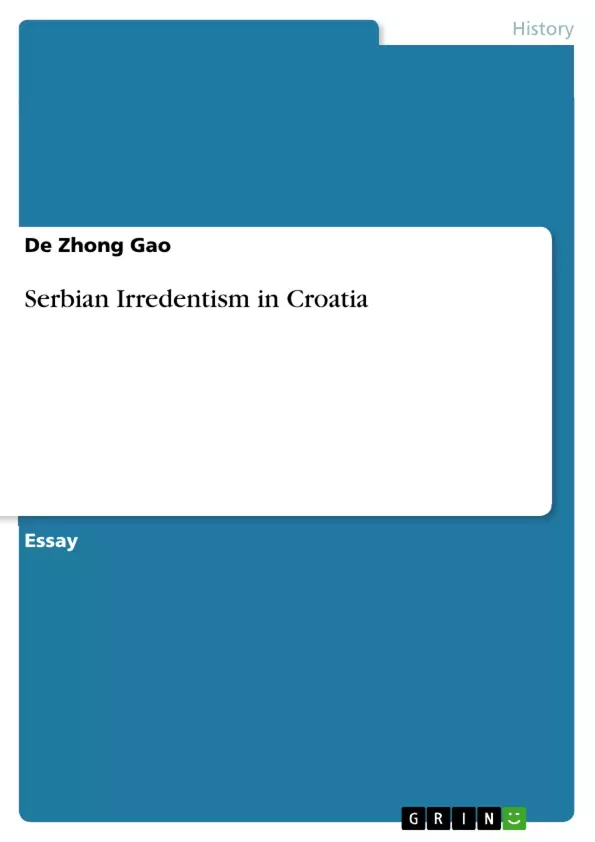The following essay argues how the ethnic bargaining model and theory of fear provide a better understanding of ethnic irredentism and violence in Yugoslavia. This essay analyzes how institutional arrangements of the republics in the former Yugoslavia affected the collapse of the Yugoslav federation, and demonstrates how Jenne’s ethnic bargaining model and Lake and Rothchild’s theory of fear account for the origins of the Serbian-Croatian conflict.
Inhaltsverzeichnis (Table of Contents)
- An Uneasy Federation
- A Federation of Republics
- The Yugoslav Constitution
Zielsetzung und Themenschwerpunkte (Objectives and Key Themes)
This essay aims to analyze the origins of the Serbian-Croatian conflict within the framework of the ethnic bargaining model and the theory of fear. It seeks to understand why ethnic rivalries escalated into violence in some instances but remained contained in others within the context of the former Yugoslavia.
- The role of state policies and institutional arrangements in shaping ethnic conflict.
- The impact of power demographics and resource distribution on inter-ethnic relations.
- The influence of information manipulation and fear in escalating conflict.
- The concept of irredentism and its contribution to the Serbian-Croatian conflict.
- The application of the ethnic bargaining model and the theory of fear to explain the collapse of Yugoslavia and the subsequent violence.
Zusammenfassung der Kapitel (Chapter Summaries)
An Uneasy Federation: This chapter explores the complex factors contributing to the instability of the Yugoslav federation. It examines the diverse ethnic and religious composition of Yugoslavia, highlighting the pre-existing tensions and socio-economic inequalities among Croats, Serbs, and Slovenes. The chapter details how Tito's leadership, while initially successful in mediating ethnic differences and providing a unifying force, ultimately failed to address the underlying issues of nationalism and uneven development. The chapter also analyzes the impact of the collapse of the Soviet Union and the weakening of socialist ideology on Yugoslavia's stability, setting the stage for the rise of nationalist sentiments and the eventual disintegration of the federation. The chapter delves into the constitutional arrangements within Yugoslavia, highlighting how the structure attempted to balance the sovereignty of the republics with the rights of individual ethnic groups, while simultaneously creating a system vulnerable to exploitation and manipulation by nationalistic forces. The interplay between centralized power and the formal recognition of ethnic autonomy created a precarious equilibrium that ultimately proved unsustainable.
Schlüsselwörter (Keywords)
Serbian irredentism, Croatian conflict, ethnic bargaining model, theory of fear, Yugoslav federation, nationalism, ethnic demographics, power dynamics, state policies, information manipulation.
FAQ: A Comprehensive Language Preview
What is the purpose of this document?
This document provides a comprehensive preview of a language resource, including its table of contents, objectives, key themes, chapter summaries, and keywords. It offers a structured overview for academic analysis of the themes within the text.
What topics are covered in the Table of Contents?
The provided Table of Contents currently only lists "An Uneasy Federation," with sub-sections "A Federation of Republics" and "The Yugoslav Constitution."
What are the main objectives and key themes of the work?
The main objective is to analyze the origins of the Serbian-Croatian conflict within the framework of the ethnic bargaining model and the theory of fear. Key themes include the role of state policies, power demographics, resource distribution, information manipulation, irredentism, and the application of theoretical models to explain the collapse of Yugoslavia and subsequent violence.
What does the chapter summary reveal about "An Uneasy Federation"?
The summary of "An Uneasy Federation" explores the instability of the Yugoslav federation, focusing on diverse ethnic and religious composition, pre-existing tensions, socio-economic inequalities, Tito's leadership, the collapse of the Soviet Union, rising nationalism, the Yugoslav constitution, and the precarious balance between centralized power and ethnic autonomy.
What are the key terms associated with this work?
Keywords include Serbian irredentism, Croatian conflict, ethnic bargaining model, theory of fear, Yugoslav federation, nationalism, ethnic demographics, power dynamics, state policies, and information manipulation.
What theoretical frameworks are used in the analysis?
The analysis utilizes the ethnic bargaining model and the theory of fear to understand the escalation of ethnic rivalries in the context of former Yugoslavia.
What is the overall scope of the analysis?
The analysis aims to understand why ethnic rivalries escalated into violence in some instances but remained contained in others within the former Yugoslavia, focusing on the Serbian-Croatian conflict.
- Arbeit zitieren
- De Zhong Gao (Autor:in), 2013, Serbian Irredentism in Croatia, München, GRIN Verlag, https://www.grin.com/document/265273



